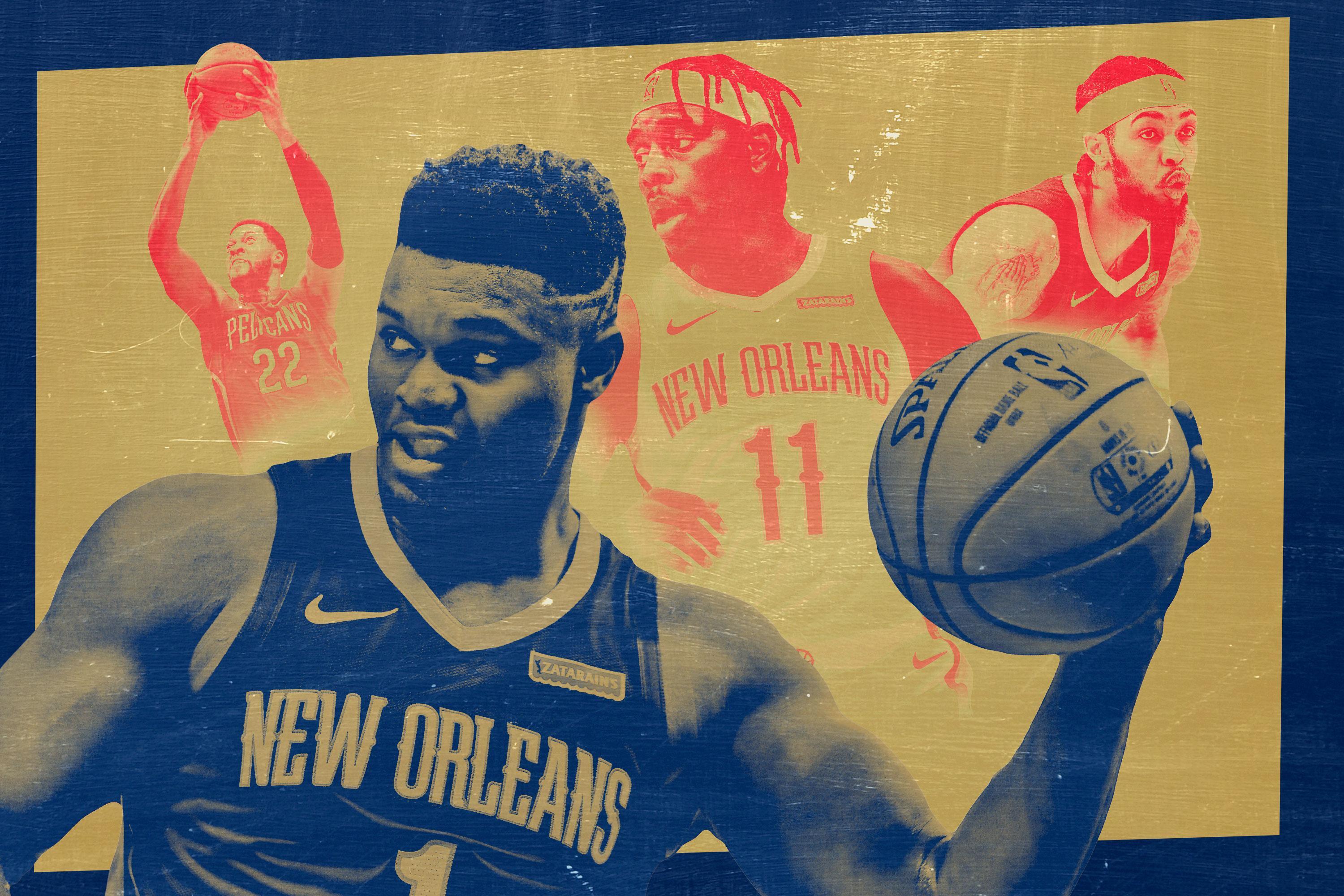
Zion Williamson is returning to a better situation than it appeared a few weeks ago. The Pelicans were one of the first half’s most disappointing teams following the no. 1 pick’s preseason meniscus surgery. But they have shown signs of life recently, going 5-2 over the past seven games, including a Christmas Day win in Denver. Zion is expected to make his long-awaited NBA debut soon, which will increase the spotlight on the team considerably. New Orleans will have an interesting decision to make once he’s up to speed.
The Pelicans’ resurgence began with the return of a different big man. Derrick Favors, whom they acquired from the Jazz in the offseason, has been limited by knee and back injuries and also missed time after the death of his mother. New Orleans looked more like the team everyone expected it would be coming into the season as soon as he resumed his normal workload. The Pelicans are 7-3 when Favors plays more than 25 minutes in a game this season and 5-21 when he doesn’t.
It’s not that Favors is a star. He’s averaging 8.9 points per game and doesn’t possess the same athleticism as he did when he was younger. But the 10-year veteran fills a role that none of the Pelicans’ other big men could. Favors can anchor the defense, finish at the rim, and find the open man when the defense collapses. Put a center like that in the middle of all the quality perimeter players in New Orleans and everything falls into place. The biggest question regarding Zion’s return is whether they’ll put him in that spot.
The Pelicans had plenty of talent on the floor even without their rookie sensation. The problem was their glaring hole at center. When Favors was either out or on a minutes restriction, New Orleans coach Alvin Gentry used a platoon of Jaxson Hayes, the no. 8 pick in this year’s draft, Jahlil Okafor, and Nicolò Melli at the position. Hayes is the only credible rim protector of the bunch, and he’s a raw teenager who gets pushed around and can’t stay out of foul trouble (5.5 fouls per 36 minutes of playing time). Once Okafor or Melli came in, things fell apart completely.
Pelicans Centers
Their numbers with Favors might actually undersell his contributions. So much of the Pelicans’ time with Favors this season came when he was in and out of the lineup in the first two months without ever getting into a rhythm. The Pelicans have an eye-popping net rating of plus-11.6 in 212 minutes with him on the floor over the past seven games.
There were a lot of questions about how all of the new faces in New Orleans would fit together this season. But Gentry seems to have found something recently by starting Lonzo Ball, JJ Redick, Jrue Holiday, and Brandon Ingram around Favors. The exciting part is that it’s not just Favors who is making those lineups work. Lonzo and Ingram have both made dramatic improvements after coming over from the Lakers this summer in the Anthony Davis trade.
Ingram is one of the front-runners for the Most Improved Player Award, averaging 24.9 points on 48.1 percent shooting, 6.8 rebounds, and 3.8 assists per game. But everyone knew that he could put up numbers if given a bigger role. The key development is that he’s started knocking down 3s, shooting 40.1 percent from deep on 5.8 attempts per game this season after shooting 32.9 percent on 2.0 attempts per game over the previous three. His improved stroke means that Ingram can now thrive whether he’s playing on or off the ball, making him more interchangeable than he was with the Lakers.
It’s the same story with Lonzo, although he had to make a few more tweaks than Ingram. He completely rebuilt his jumper in the offseason and is now shooting 3s at a higher clip (6.3 per game) and percentage (35.6) than ever before. While there are still times when his shot is off and defenses elect to leave him open, he’s become a respectable enough shooter to stay on the floor. That was all that he ever needed to be, because he can do so many other things well on the court.
The Pelicans can now run pick-and-rolls with either Ingram or Holiday (who is still an elite two-way guard) with Favors screening, while Ball and Redick help space the floor. The only bad defender of the five is Redick, and they can replace him with two 3-and-D shooting guards if they need stops—Josh Hart (the other player they received in the AD trade) and E’Twaun Moore.
The biggest concern with Zion’s return is that he could mess up their spacing if he’s playing next to Favors. The Pelicans have been one of the best 3-point shooting teams in the NBA this season (no. 5 in 3-point attempts per game and no. 7 in 3-point percentage). Playing Zion and Favors together would change that.
Neither can threaten the defense from the perimeter. Zion shot a respectable percentage from 3 in college (33.8) but on a limited number of attempts (2.2 per game), and his poor free throw shooting numbers (64.0 percent on 6.2 attempts per game) and line-drive jumpers mean that he will likely need more time to extend his range. Utah spent the past few seasons trying to squeeze Favors into a role as a stretch 4 next to Rudy Gobert without much success. Both players will be more effective when they are rolling to the rim with four shooters around them than they’ll be when trying to space the floor for someone else.
Zion might be skilled enough to make it work in limited minutes. He’s a good passer who knows how to cut and move without the ball, which would allow him to occupy the defense when he’s not involved in the play. But the best version of the Pelicans will likely be with Zion at the 5, not the 4.
He’s far more than just a dunker. Zion is one of the most interesting NBA prospects in recent memory because he has the skill and basketball IQ to go with his physical tools. He put up historic numbers in the preseason—23.3 points on 71.4 percent shooting, 6.5 rebounds, 2.3 assists, and 1.5 steals in 27.3 minutes per game. Surround a player like him with four 3-point shooters who can open up the paint and he could be nearly unstoppable.
The offense is only half the equation. Zion is the rare rookie big man who might be able to immediately handle the demands of playing center on defense. The contrast between Zion and Hayes is telling. Zion, at 6-foot-6 and 285 pounds, is far stronger than Hayes, and has much better instincts. Hayes, at 6-foot-11 and 220 pounds, is a more typical NBA teenager who depends on his athleticism to bail him out when he makes bad decisions. Zion uses his athleticism to make good decisions even better. He averaged 2.1 steals and 1.8 blocks per game as the anchor of the no. 8-rated defense in the country at Duke last season. He showed the ability to protect the rim, hold his own in the paint, and stay in front of smaller players on the perimeter. There’s a reason Pelicans executive vice president David Griffin compared him to Draymond Green. He has that type of defensive potential as a small-ball 5.
The question for New Orleans is how much it wants to play him at that position. It’s a lot harder to play center in the NBA, where almost every team has multiple 7-footers. A lot of teams try to protect their young big men from spending too much time banging with bruisers like Steven Adams. Memphis traded for Jonas Valanciunas and signed him to a three-year, $45 million contract so that he could take some of the pounding for Jaren Jackson Jr. Jackson has been much better at the 5 than the 4 this season, with both his usage rate and efficiency numbers skyrocketing, but the Grizzlies are thinking long-term. He’s a 20-year-old who struggles with foul trouble and still needs to add weight to his frame. There will be plenty of time for him to shift over as he gets older. The problem for the Pelicans is that Zion can’t shoot like Jackson, making it harder to pair him with a traditional big man.
And while he has a much different body type than Jackson, many of the same questions apply about playing him at center. Zion is coming off a serious knee injury, which happened before he even began playing in the NBA. The Pelicans have reportedly been working with Zion to change the way he runs and jumps in order to reduce stress on his knees. Playing him against smaller and less physical players at power forward would also put less pressure on him physically.
Blake Griffin is the cautionary tale hanging over Zion. He was just as good of an athlete when he came into the league a decade ago, dunking on everyone in his path. And like Zion, he injured his knee in the preseason as a rookie. The Clippers were cautious with Blake, keeping him out his entire rookie campaign. But there was only so much they could do to protect him. There was a timetable for how long a player with his size could run and jump at that level before his knees gave out. Griffin has been steadily declining physically over the past few years, and has played only 18 games for Detroit this season while struggling with a lingering knee issue. The 30-year-old is now reportedly considering shutting himself down in order to undergo another knee surgery. There’s just no way to know how Zion’s body will respond to the NBA. We’ve never seen a player like him before—he’s almost 40 pounds heavier than Griffin.
New Orleans could avoid this dilemma by trading for a stretch 5 like Myles Turner, who could defend bigger centers while spacing the floor for Zion on offense. The only stretch big man on the Pelicans’ roster is Melli, a 28-year-old rookie from Italy, and he has already shown that he can’t handle playing as a 5 on defense. The Pelicans have plenty of draft picks and young players to make a trade for a player like Turner, considering all the future assets they acquired in the AD deal, whether it happens at the deadline or in the offseason.
Believe it or not, the rebuild could already be over in New Orleans. For as bad as they were in the first two months of the season, they are not that far away. The bottom of the West is so bad that they needed only one win streak to get within three games of the no. 8 seed. All they were missing was a center who could hold their own. Favors has been good in that role, but Zion could be great. The Pelicans have the pieces to succeed if they play him at the 5. It just remains to be seen how much they will.

